#Marv Wolfman Story
Explore tagged Tumblr posts
Text
FANTASTIC FOUR #217 (1980) Joe Sinnot Cover & John Byrne Pencils, Marv Wolfman Story, Death of HERBIE (Destruction)
#FANTASTICFOUR #217 (1980) #JoeSinnot Cover & #JohnByrne Pencils, #MarvWolfman Story, Death of #HERBIE (Destruction) "Masquerade!" As Reed immerses himself in the task of repairing the Baxter Building's systems from last issue, Sue berates her husband for sending Franklin to Whisper Hill to be looked after by #AgathaHarkness, and for ignoring her protestations before walking out on her husband. https://www.rarecomicbooks.fashionablewebs.com/FantasticFour%202.html#217 @rarecomicbooks Website Link In Bio Page If Applicable. SAVE ON SHIPPING COST - NOW AVAILABLE FOR LOCAL PICK UP IN DELTONA, FLORIDA #RareComicBooks #KeyComicBooks #MCU #MarvelComics #MarvelUniverse #KeyComic #ComicBooks

#FANTASTIC FOUR#217 (1980) Joe Sinnot Cover & John Byrne Pencils#Marv Wolfman Story#Death of HERBIE (Destruction)
2 notes
·
View notes
Text

Presenting... my finally completed collection of the 1996 Nightwing series!
The only exception, of course, being Devin Grayson's #71-100 which were never collected in Nightwing titled graphic novels. But anyway, this series I highly recommend starting with if you want to read Nightwing-- not with comics that were released later. I know they're popular and the art is more modern, but trust me. Post-Crisis (generally) gives a much deeper look into his character.
#nightwing#nightwing 1996#dick grayson#boy wonder#dc comics#comic collector#comic collection#new earth#post crisis#chuck dixon#marv wolfman#peter j. tomasi#you can skip brothers in blood#terrible story and OOC#also please do not start with tom taylor#i started with new 52 by rec#i wish i had started with this instead
35 notes
·
View notes
Note
Hi sorry not to be weird but you're the local Rose expert and I was wondering if you could help me? I'm trying to figure out what ethnic group Lili Worth belongs to. I know she's from Cambodia so logic says she would most likely be Khmer, but the fact that she was fleeing the Khmer Rouge puts that kinda in doubt for me? I've seen a few things saying she's Hmong which would make sense as they were a minority group during the Cambodian Genocide but they're a pretty small portion of the population and I haven't seen anything canon supporting it, just fan posts. When it comes to Lili I've really only read Deathstroke the Terminator (1991) so I'm not super familiar with her. Sorry for any trouble!
!!! no trouble at all <3
as far as i know it never specifically said which ethnic group she was pre-52, but in deathstroke #15 slade says that lili was a "local princess in the siem pang"
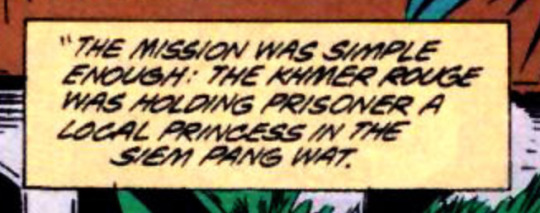
honestly i dont know a lot about the different ethnic groups in cambodia but google says that the common ethnic groups in the siem pang are the khmer and lao. i guess we can assume shes lao since she was fleeing the khmer rouge? but unfortunately the real answer is that marv wolfman put 0 thought into any of this
but then. in deathstroke #43 suddenly she says she was trained by the khmer rouge??? idk if this is a retcon or if we're supposed to assume that they trained her to fight while she was imprisoned???? odd choices all around tbh
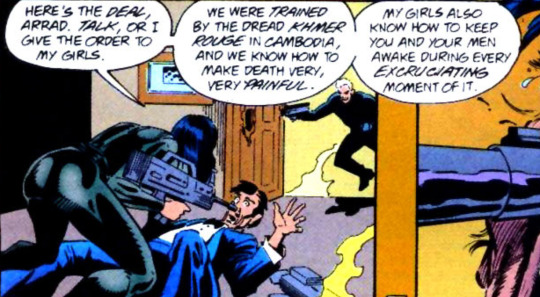
so short answer: its not specified and wolfman probably didnt even consider any of it for more than 5 seconds
but!!! during rebirth in deathstroke (2016) she and rose are confirmed hmong!
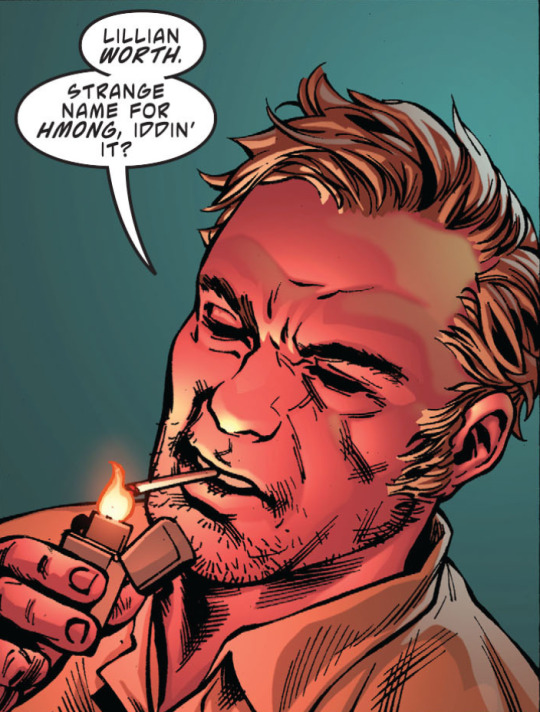
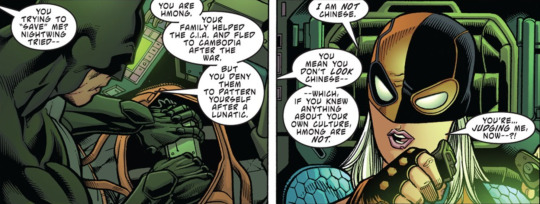
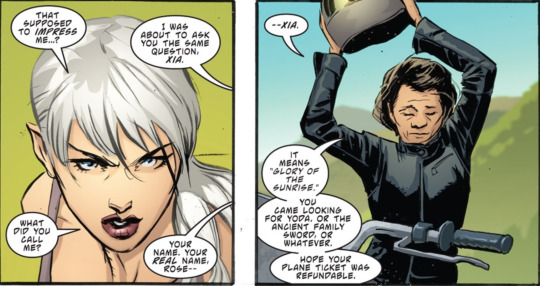
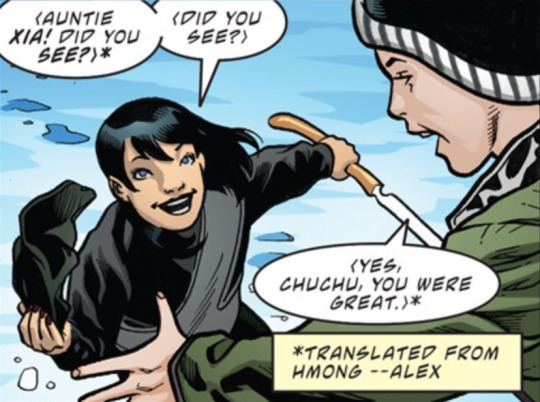
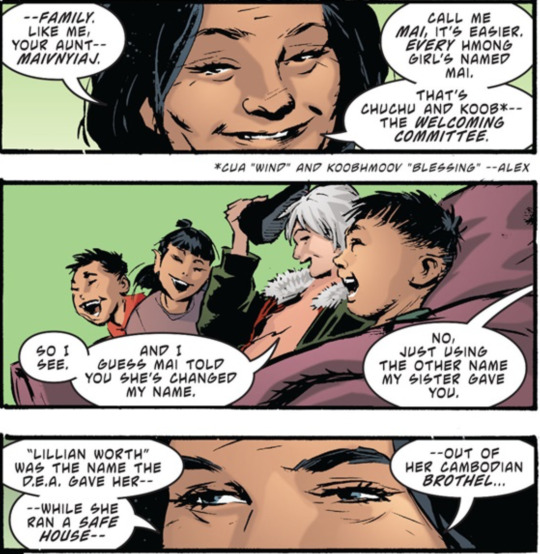
and they've been hmong ever since <3
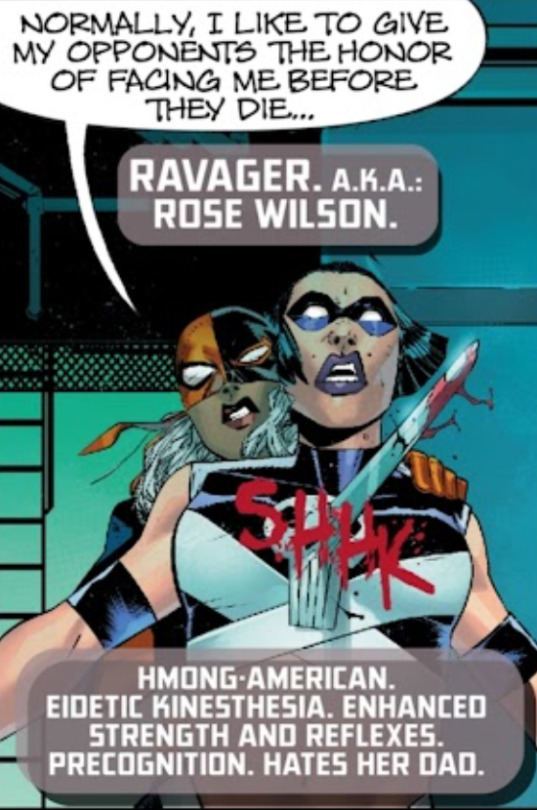
#once again i know very little about cambodian ethnic groups and most of my knowledge comes from spending the last hour googling#so i could be way off#but i’ve probably done more research in the last hour than marv wolfman ever bothered to do about it#anyways. the change from cambodian -> hmong in rebirth is so strange bc there wasnt really a reason to change it ??#but if dc ever stops mentioning that rose is hmong ill start killing tbh!#bc it was never mentioned pre52 </3 then in the new52 suddenly she was white and lili didnt exist <////3#but rebirth!!!! she had multiple arcs about her heritage#and an extensive story about her connection to her moms family vs her father then giving up being ravager#(williamson kys for undoing it)#so her being hmong is an important part of her character in ds16 in a way it never had been before <33333#christopher priest if u ever need $1000 or a kidney just hmu ill do anything for you
12 notes
·
View notes
Text
the jess drew laser retcon gets me EVERY time like what the fuck was bendis on. like he thought "jessica's mother got shot directly in the womb with a magic spider gene splice laser beam and then didn't go to the doctor about it" was more believable than "experimental medical treatment". and they published it
#also the whole hydra fake boyfriend thing but whatever#actually not whatever. how do you make your origin story weirder to a teenage girl than marv fucking wolfman did#p
26 notes
·
View notes
Text
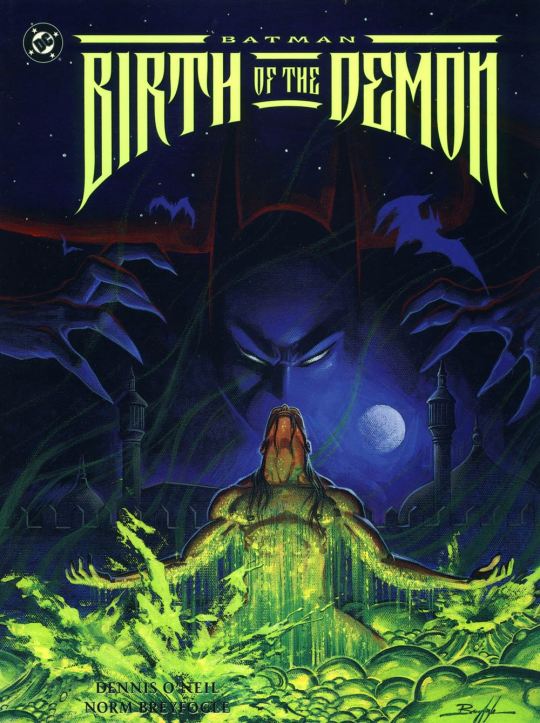
December 1992. I've never quite made up my mind about this graphic novel, originally released as a slim, very expensive hardcover, and intended as the definitive origin of Ra's al Ghul. Here are some pros and cons:
It's the best Batman story Denny O'Neil ever wrote, at least from the standpoint of execution. A lot of O'Neil's classic Batman stories were written as inventory stories, and feel like it; were it not for Neal Adams' art on some of them, they would not be nearly as highly regarded as they now are, and some are real stinkers. In construction, theme, characterization, and mood, this might be his most accomplished comics work.
It's appalling Orientalist hokum, even for O'Neil. In the interests of avoiding any possible politicization of Ra's al Ghul (who is fundamentally an Arab version of Fu Manchu, much as O'Neil and Adams tried to deny it), his origin is set in a fantasy Arabian kingdom that no longer exists and has no sense of actual place or period — lazy, non-confrontational worldbuilding for white readers who consider 1,001 Nights too gritty and realistic.
I've never liked Norm Breyfogle's art, so having him draw this important story was not a plus. (I know some people love Breyfogle's work, it's fine, a matter of taste, don't @ me.)
It has some of Breyfogle's best pencils, but the painted color was a mistake. Painted comics were briefly "in" around this time, and I guess it was a way to add a sense of occasion, but it tends to undermine the penciled art, which is admittedly quite good.
I'm not convinced Ra's al Ghul needed — or benefited from having — a real origin. O'Neil does try to hedge this in the text by presenting the origin as the account of a now-dead former associate, the veracity of which would be nigh-impossible to verify, but as with the Joker's origin in THE KILLING JOKE, once it was out there, it was going to be treated as canonical unless someone made an active effort to debunk it. I tend to think a character like Ra's al Ghul works better if Bruce is never quite sure how much is real and how much is smoke and mirrors, which was certainly the vibe in O'Neil's earlier Ra's stories. I always assumed that one of the reasons O'Neil was so antipathetic to Ra's stories he didn't write was that they were too literal, so I dunno.
It's better than its immediate predecessors, SON OF THE DEMON (which has lovely Jerry Bingham art for a frustrating story) and BRIDE OF THE DEMON (which has no virtues I can think of), but every time I look at this book, all I can do is sigh and click my teeth.
#comics#batman#birth of the demon#denny o'neil#norm breyfogle#ra's al ghul#bruce wayne#talia al ghul#this story effectively decanonizes marv wolfman's “the lazarus affair” from 1980–1981#and to some extent son of the demon (which I guess o'neil really didn't like) although morrison later tried to hybridize them#son of the demon feels too much like an '80s bond movie#and has some unnecessarily ugly violence that drags down the vibe#bride of the demon feels like a low-budget italian knockoff of american blockbusters#made with props left over from another movie with lots of stock footage and terrible dubbing#no scratch that it makes it sound better than it actually is
6 notes
·
View notes
Text
Beast Machine Hunters> The First Story Bible finale
BW concludes phase one of Beast Machine Hunters with The First Story Bible finale, completing our look at Marv Wolfman's Beast Hunters story treatment.
Last time we finished Marv Wolfman’s story treatment but the whole story treatment includes one last section. In this part the focus is a description of the Maximals and Vehicons themselves, and while there are two more books to review in this series it is the end of the Beast Hunters version of what became Beast Machines. The biggest issue with Wolfman’s treatment–outside of more typos than me,…

View On WordPress
#Beast Hunters#Beast Machines#Mainframe Entertainment#Marv Wolfman#story treatment#Transformers#Transformers: Beast Machines
0 notes
Text

What’s wrong with me, father?
#machine man#Aaron stack#x-51#father#origin story#adjustment#human?#marv wolfman#steve ditko#marvel comics#comics#70s comics#bronze age comics#machine man: the living robot
1 note
·
View note
Text
"To me, Dick is the one hero who simply decided being a fighter for justice was the right thing to do. The murder of Dick's parents was solved almost immediately so there was never a feeling he needed revenge. Even back when he was created he was someone who made bad jokes and seemed to have fun doing what he did. He wasn't the sole survivor of a doomed planet. He didn't feel responsible for the death of his parents. He wasn't appointed an intergalactic cop. When Batman put his parent's killer behind bars he saw that stopping crime was something worth believing in. Dick is the only one I know who is like that. And he does it without having been given any special powers. To me Dick is the best kind of character there can be; he's dedicated to his cause for all the right reasons. Plus he's human, so Dick has to work hard to be good. Unlike Superman he has no natural powers. Shoot him and he will be hurt. That makes the story more interesting."
-Marv Wolfman
Dick Grayson, Boy Wonder : Scholars and Creators on 75 Years of Robin, Nightwing and Batman.
#DC Comics#Dick Grayson#Nightwing#Robin#Batman#Marv Wolfman#Dick Grayson Boy Wonder: Scholars and Creators on 75 Years of Robin Nightwing and Batman
662 notes
·
View notes
Note
Just letting you know, there's an anon going around messaging people that you ship a child with their caretaker and urging them to reconsider interacting with your posts
Thank you to the anon who messaged me about this, and thank you to the anon who is unhappily engaging with my work! As a fine artist, comic artist, and person who likes to think about culture, stories, and history, I’ve been wanting to write about the Dynamic Duo for a while. This is a good opportunity for getting those various drafts together. And for anyone who’s curious about DC comic dynamics and likes, like me, to play with comics… I hope this can be an interesting little read into the various ways of reading Batman and Robin, and why one might choose to engage in a queer reading of “Brudick.”
Bruce and Dick: Father and Son, Brothers in Arms, Partners Fighting Crime
First, Bruce and Dick can certainly be read as “Father and Son.” There are several Dynamic Duo stories from various decades that do this, some of which I quite enjoy.
Like in Batman Vol. 1, No. 20 (1944), where Bruce has to fight Dick’s corrupt blood relations to retain guardianship of his almost son/best friend.

And in writer Tom Taylor, artist Bruno Redondo, colorist Adriano Lucas, and co.’s Nightwing comics, including Nightwing Vol. 4, No. 100 (2023).


But “Father and Son” isn’t their only definitive relationship.
Dick wasn’t adopted by Bruce at first for logistical reasons inside and outside of text (the difficulties of single men adopting kids during the 40s, when Batman and Robin was first published, for example.) There are comics that describe them as brothers for example, including when Dick first leaves to attend university as a young man and when he dons the Batman cowl after Bruce “dies.”
Batman & Robin Vol. 1, No. 7 (2009) by Grant Morrison, Cameron Stewart, and co.

Batman Vol. 1, No. 217 (1969), by Irv Novick, Dick Giordano, and Frank Robbins.

(Said vow of manliness was then followed up by Dick crying like a heartbroken heroine of a 1960s romance comic.)


Young Romance No. 125 (1963)
Dick and Bruce have even, on significant occasions, denied being father and son (though one could choose to read that as the first step of a cautious, tsundere journey towards patrilineal bonds)
Batman Vol. 1, No. 439 (1989), by Marv Wolfman, Pat Broderick, Adrienne Roy, and co.

The bond that Bruce asserts with Dick in this compelling story is based not on him replacing Dick’s parents, but on bonding with him as a similarly traumatized and wounded child.

This resonates with the words of David Mazzuchelli, fantastic mainstream and indie comic artist behind Batman: Year One. In the “Afterwords” section of Year One, Mazzuchelli describes the pair as being a pair of innocent, un-sexed twelve-year-old boys (Bruce mentally) who connect as best friends pretending to be heroes.

(Take a look at Austin Kleon’s blog for the full post where this comes from – all photo credits to him)
This reading of the Dynamic Duo who are mainly partners, fighting against the crime that destroyed their parents, vibes with Darwyn Cooke’s beautifully rendered DC: The New Frontier (2004).

As Batman explains, they are “two lost souls who found each other”... romantic, no?
2. Bruce and Dick: Romantic Partners
With all the various interpretations of Bruce and Dick over the decades, from the perspectives of various writers and artists, there is also room for a romantic reading. Not just the comic panels taken out of context and spoofed on the internet. From this Reddit post…

…To “A Brief History of Dick: Unpacking the gay subtext of Robin, the Boy Wonder”, a great summary by Glen Weldon, author of The Caped Crusade: Batman and the Rise of Nerd Culture. The comics themselves are ripe for various – *eh-hem* – creative readings and misinterpretations.

Canon Jokes about Batman and Robin’s Relationship
But Bruce and Dick’s ambiguous relationship is also referenced in DC’s canon comics, like World's Finest Year 6: The Imp-Possible Dream (1999) by Karl Kesel, Peter Doherty, and Robert Campanella.

By aligning Dick with Lois Lane, damsel in distress, DC’s officially published comics pokes at the stability of a purely platonic father and son relationship between the Dynamic Duo.
Then there are the much more disturbing jokes from the Joker in Arkham Asylum: A Serious House on Serious Earth (1989) by Grant Morrison and Dave McKean.



Joker makes plenty of insinuations about Batman’s mental wellness and his attraction to a Robin. Queerness as pathological isn’t new to Batman – it’s embodied in the Joker, a lipstick and acrylic-wearing man obsessed with another man. Joker not only evokes drag queens; in Batman: The Dark Prince Charming (2017-2018) by Enrico Marini, he even dresses as one.

It’s easy to forget the Joker’s queerness with Heath Ledger’s highly popular elemental Joker, Joaquin Phoenix’s sad boy follow-up, and the heterosexual, Harley Quinn-touting Joker of the Batman animations. But I think Joker has lasted – and surpassed Robin in popularity – because Robin was a good boy who was scandalously attached to gay jokes while Joker was a bad guy, who one, historically, could easily accept as being evil.

And then Robin became the Joker.
Like Sin City, Frank Miller’s infamous Batman: The Dark Knight Strikes Again is a testosterone and titty fueled extravaganza. And it makes Dick a Joker mutant targeting Bruce’s new sidekick, former female Robin, current lovely Catgirl, Carrie Kelly. A side-by-side comparison shows who is more desirable and healthy amongst them.


Dick envies Carrie, going so far as plotting to steal her body by skinning her alive.

It’s not a good look on Dick. It is also sad, twisted, and one of the most fascinating ways Frank Miller could have acknowledged Dick’s mixed cultural legacy within DC published comic (even one set in an alternate universe). Here is a panel of Dick declaring his wicked love, driving Bruce to (lover’s) suicide.

So there is room for laughable and sick interpretations of romantic Brudick. Now let’s take a look at a healthier option for these not-quite lovers, enemies, partners, and family members.
3. Batman’s (and Robin’s) Queer Liberation: Fredric Wertham, Feminism, and Kevin Conroy
I’m personally captivated by a romantic reading of Bruce and Dick. Stories revolve around conflict and that poses A LOT OF PROBLEMS. It also has led to plentiful interesting fanart and fanfiction that tries to make sense of decades of stories with a cohesive narrative. While there’s plenty of porn (which, no anti is entitled to shame others about), it also involves strangely compelling coming-of-age stories that few other slash pairings can inspire.
Also, Bruce and Dick’s queer potential is really important for Western comics history – it’s part of what Fredric Wertham M.D. took comics to task for in the 1950s, leading to a (flawed) study, a Senate Hearing, censorship and comic codes, as well as the creation of family friendly female characters! Wertham clearly read the comics as queer – and that still holds currency for other LGBTQIA comics fans who see themselves in Batman and Robin.
Excerpts from pg. 190 of Fredric Wertham’s Seduction of the Innocent (1954):

Wertham also accuses Wonder Woman and her friends of loving women to the detriment of men on page 193:

DC superhero media has a history of deviant queerness – to say no is to deny an important facet of comics history.
Mining said queerness can give room for female characters to be more than objects of men’s violence/sexual objectification. One of my favorite Batgirl comics gets Batgirl away from Dick Grayson, putting her on her own journey of friendship, love, and self-fulfillment in the capable hands of Babs Tarr.
From Batgirl, Vol. 4, No. 40 (2015):

Other female characters who have flourished when given the ability to be more than love interests include Batgirl’s bestie, Supergirl, in Supergirl: Woman of Tomorrow (2021-2022) by Tom King, Bilquis Everly, and co.

Superhero stories are so big, full of questions about what makes a person moral and how/whether they can ever truly belong. Do stories that play with Bruce and Dick as romantic connect to those ideas? They certainly do.
And, as we see from the autobiographical comic of Kevin Conroy, iconic voice of various animated Bat-men, these questions and deviations can enrich our superhero stories too. Excerpts below from “Finding Batman” by Kevin Conroy, J. Bone, and Aditya Bidikar, published in DC Pride 2022.



The Batman and Robin stories are so strange, plentiful, and varied – there’s room for various interpretations, none of them “wrong.”
If the anon who’s messaging other social media users to stop looking at my art wants to tackle issues like child exploitation, or if they want to support girls and women who are in danger of incest or rape, they can donate and spread awareness of organizations like Save The Children, Planned Parenthood, and others using ProPublica’s Nonprofit Explorer.
And for wholesome DC comic recs with gals of color, I recommend DC comics like Diana and Nubia: Princesses of the Amazon (2022) by Shannon Hale, Dean Hale, and Victoria Ying and Girl Taking Over: A Lois Lane Story (2023) by Sarah Kuhn and Arielle Jovellanos. My twin collaborator and I are also working on stories that tackle superheroines and intersectional feminism – stories which criss-cross with our platonic and romantic Brudick stories!
#dick grayson#bruce wayne#batman#batman and robin#dc comics#meta writing about making art and stories#not sure if the original anon will ever see this...#But if it interests others who are shippers or non-shippers!#I like thinking about comics#comics history
164 notes
·
View notes
Text
Dorothy's Big List of Comic Book Recs - DC Comics Edition
I often get asks about getting into comic books, and how daunting it seems, given the huge back catalog of titles and issues available. I'm here to tell you it doesn't have to be scary! From miniseries that act as good introductions to characters to runs on ongoing titles by individual creators that serve on jumping-on points, there's lots of ways to get into comics without having to have a lot of background knowledge, and I'm going to give you a lot of potential places to start. Please note that this post only covers DC Comics; Marvel and indie lists will follow! Also note that I haven't read everything, and I won't recommend something I haven't read, so a few runs or books some consider must-reads may not be on here. This is based purely on books I have read and enjoy, and that I think are suitable for new readers. I'm also not including books from the Milestone and Wildstorm imprints as they're kind of a separate sphere to me, although some Vertigo books may be included.
SUPERMAN
All-Star Superman by Grant Morrison and Frank Quitely: This is the book that made me a Superman fan. It is an out-of-continuity celebration of Superman and his world, and an exploration of why Superman as a character has endured for nearly a century.
Superman For All Seasons by Jeph Loeb and Tim Sale: A gorgeously-illustrated and Americana-flavored recounting of Superman's early years in Metropolis, anchored narratively by the changing of the seasons.
Superman: Birthright by Mark Waid and Lenil Francis Yu: For my money, the definitive origin story for Superman. Great characterization of the entire supporting cast, including Lex Luthor, make this a perfect entry point into the character and his world.
Action Comics (1939) and Superman (1939) by Jerry Siegel and Joe Shuster: The earliest Superman stories are still really great, and have a populist edge that many later stories sanded down. They're pulpy and fun and I recommend them!
Action Comics (2011) by Grant Morrison: This run spans issues 1-18, plus a special issue 0, of the series launched as part of DC's mostly-failed 2011 reboot, and covers Superman's early years in this continuity. The early issues bring back some of the edge that was present in the Golden Age comics, and the rest of the run is solid stuff as well. Morrison always comes highly recommended.
Superman: Red and Blue: An athology series that focuses on a broad sampling of Superman's world and supporting cast, written and drawn by various creators.
Action Comics (1939) by Geoff Johns: Specifically, I would say that issues 855 to 870 are a good span to be checking out for Geoff Johns' run on the book. These include some great stories focusing on classic Superman villains such as Bizarro, Toyman, and Brainiac.
Superman Smashes the Klan by Gene Luen Yang and Guruhiru: An adaptation of a classic Superman radio story set in the 1940s and focusing on Superman's place as an immigration narrative. And Superman gets to rough up some Klansmen!
Man and Superman by Marv Wolfman and Claudio Castellini: Another story of Superman's early years, this one focusing on his struggles to adapt to life in the big city after moving from Smallville, as well as his first encounters with Lois Lane and Lex Luthor.
Superman: Up in the Sky by Tom King and Andy Kubert: A lovely self-contained story which demonstrates just how far Superman will go to save a single life.
Superman (1939) by Elliot S! Maggin: This mammoth run spans issues 247 to 400 of the classic title, and includes some fantastic stories such as "Must There Be a Superman?" (issue 247), "The Greatest Green Lantern of All" (issue 257), and "The Living Legends of Superman" (issue 400)
Superman (1939), Adventure Comics (1938) and Action Comics (1939) by Mort Weisinger: This run spans a lot of the Silver Age era of Superman, including Action Comics #241-392, Superman #120-231, and Adventure Comics #247-396. It's a lot of issues, but in those days you can mostly read them in any order since they're pretty self-contained. This run includes a lot of classic villains and stories, as well as the earliest adventures of the Legion of Super-Heroes.
Supergirl: Woman of Tomorrow by Tom King and Bliquis Evely: A spacefaring take on a True Grit-style western with gorgeous art, and a definitive story for the Girl of Steel.
Superman’s Pal, Jimmy Olsen (2019) by Matt Fraction and Steve Liber: a madcap romp and a delightful sendup of Silver Age weirdness.
BATMAN
Batman: The Long Halloween and Batman: Dark Victory by Jeph Loeb and Tim Sale: Another Loeb/Sale joint, focusing on Batman's earlier years and the transition of Gotham's underworld from the mob to a coterie of costumed kooks.
Arkham Asylum: A Serious House on Serious Earth by Grant Morrison and Dave McKean: An examination of the facility housing Batman's rogues, and what those rogues symbolize in his world.
Batman (1940) by Dennis O'Neil: This is a classic run which re-established a dark tone for the Dark Knight which has endured to this day. The run spans Batman #224-268, along with a handful of issues of Detective Comics. Among the major developments of this run are the introduction of Ra's al Ghul and his daughter Talia.
Batman: A Lonely Place of Dying by Marv Wolfman, George Perez, and Jim Aparo: The definitive story about why Batman needs Robin. Read it in trade since the story spans both the Batman and New Titans titles.
Batman by Grant Morrison: I'm hesitant to include this because it delves so deep into Batman lore, but it really is essential reading, introducing Damian Wayne along with other concepts. Please do disregard Morrison's frankly appalling characterization of Talia. Read in omnibus format as the run spans multiple titles.
Batman: The Killing Joke by Alan Moore and Brian Bolland: It's cliche at this point but the story still is fantastic and one of the best Joker stories ever written.
Batman: No Man's Land: An epic storyline across many titles dealing with Gotham being cut off from the US after a massive earthquake and Batman's efforts to keep the peace in an abandoned city. Read in trade format.
Batman (2011) by Scott Snyder: This run spans issues 1 through 51 of the New 52 relaunch, and introduces concepts such as the Court of Owls. It's a fun run, including a brief period where Jim Gordon acts as Batman.
Batwoman (2011) by J.H. Williams III and W. Hayden Blackman: A gorgeously-illustrated book about Batman's cousin and her adventures as the Batwoman. Worth reading for the art alone.
Nightwing (1996) by Chuck Dixon: Dixon's a tool but this is still the definitive Nightwing run. This run includes volume 1 of Nightwing, a 4-issue mini, as well as issues 1-70 of volume 2, which establishes Dick's home base of Bludhaven as well as his rogues' gallery.
Detective Comics (1937) by Paul Dini: This run spans issues 821 to 852, and features some great stories by one of the great Batman writers and a co-creator of the classic animated series.
Robin (2021) by Joshua Williamson: A great run that helps to flesh out Damian Wayne's place in the DC Universe.
The Boy Wonder by Juni Ba: A great story with gorgeous art that focuses on Damian Wayne and his relationships with the other members of the Batman Family.
Batgirl (2000): The first series to focus on a Batgirl, specifically Cassandra Cain, the best Batgirl, as she struggles to adapt to life after an abusive childhood being raised as an assassin.
WONDER WOMAN
Wonder Woman (2006) by Gail Simone: Simone's run is the longest that a woman has ever written comics' premiere female superhero, and it's just good comic book fun. The run spans issues 14 to 44.
Wonder Woman (1987) by Phil Jimenez: Jimenez's childhood love of Wonder Woman shines through in his run, which placed a renewed focus on Diana's supporting cast and especially her family. The run spans issues 164 to 188.
Wonder Woman (1942) and Sensation Comics (1942) by William Moulton Marston: Wonder Woman's creator laid down the basics of the character and her world, and those early Golden Age stories are still a great read. They're fun, engaging - and more than a little kinky with hindsight.
Wonder Woman (1987) by Greg Rucka: In the early 21st century, Greg Rucka was The Guy for writing female superheroes, and his run on Wonder Woman is great. It features Diana becoming an ambassador, writing a book, fighting Medusa, and matching wits with Veronica Cale, her own Lex Luthor. The run spans 196-226. I must also mention Wonder Woman: The Hiketeia, also by Rucka, which is a Greek tragedy where Diana finds herself torn between duty and justice.
Wonder Woman Historia: The Amazons by Kelly Sue DeConnick: A beautifully-illustrated story of the Amazons and the Greek goddesses, which lays the foundations for Wonder Woman's world.
Wonder Woman (1987) by George Perez: This run reintroduced Diana after Crisis on Infinite Earths, and the first 25 issues feature Perez's simply-unmatched artwork. The whole run spans the first 62 issues of the book, and serves as a blueprint for most subsequent takes on the character.
THE FLASH
Flash Comics (1940) and All-Flash (1941): The Golden Age Flash and his early stories by his creator Gardner Fox. Must-read if you're interested in Jay Garrick, the first Flash.
Showcase #4, 8, and 13, and The Flash (1959): The Silver Age Flash, Barry Allen, made his debut and early adventures here. Much of the art is by the great Carmine Infantino, and Gardner Fox returned to write some stories. The whole concept of the multiverse debuted in this run.
The Flash (1987) by Mark Waid (as well as Grant Morrison and Mark Millar): This run starts in issue 62 and lasts until 162, with a brief run by Grant Morrison and Mark Millar towards the end. This run is the definitive Flash run, focusing on Barry Allen's protege Wally West maturing in the role of the Flash and establishing himself as the true fastest man alive.
The Flash (1987) by Geoff Johns: This run spans issues 164 to 225, and refocuses the Flash's traditional rogues' gallery, offering modern origins for many of them, while also introducing new foes like Girder, Blacksmith, and a new Reverse-Flash.
The Flash (2016) by Joshua Williamson: This run spans issues 1-88, as well as 750 to 762 of the relaunched volume 1 of the book. I hate the recentering of Barry Allen from 2009 to 2019, but Williamson's run is the most tolerable, and serves as a love letter to the Flash, while also setting the stage for Wally to return as the primary holder of the mantle.
The Flash (2023) by Simon Spurrier: The current run of the Flash, it focuses on Wally as the main Flash and the Flash Family as an ensemble. The extended first arc features a threat to time itself, and goes into some really surreal and experimental territory for a Flash book.
Impulse (1995) by Mark Waid, et al.: A more lighthearted and comedic companion book to Waid's run on Flash, this book focuses on Bart Allen, Barry's grandson, who was raised in the future and has the attention span of a goldfish, as well as his relationship with the zen guru of speed, Max Mercury.
GREEN LANTERN
The Green Lantern (2018) by Grant Morrison: A police procedural starring Hal Jordan that gets into some pretty freaky territory, with gorgeous interiors by Liam Sharp.
Green Lanterns (2016) by Sam Humphries: A buddy cop type title focusing on the team of Simon Baz and Jessica Cruz. Humphries' run spans the first 32 issues of the book.
Far Sector by N.K. Jemisin and Jamal Campbell: A murder mystery in space which establishes a new Green Lantern, Jo Mullein. Super easy to get ahold of since it was rereleased as part of DC's Compact Comics line of $9.99 trades.
Green Lantern/Green Arrow (1970) by Dennis O'Neil and Neal Adams: This run brought a social conscience to comics as Green Arrow was reinvented as a left-winger and a man of the 60s counterculture, joining Green Lantern on a quest across America. The run spans issues 76 to 89 of the book.
Green Lantern (1990) by Ron Marz. Marz's run starts in issue 48, and sees the Green Lantern paragon Hal Jordan descend into darkness before being replaced as defender of Earth by Kyle Rayner. The run lasts until issue 125, and as Kyle is my favorite Lantern I have a fondness for it.
Green Lantern (2005) 1-67 and (2011) 0-20 by Geoff Johns: Johns brought Hal Jordan back as the main GL, and his run expanded the world of Green Lantern by introducing the emotional spectrum. His run is the basis for most Green Lantern lore going forward, and is pretty essential reading.
Green Lantern: War Journal by Phillip Kennedy Johnson and Montos: A 12-issue series featuring John Stewart as he ventures into space to fight a dark force corrupting life in the galaxy. The new definitive John Stewart run.
TEAMS AND TEAM-UPS
JLA by Grant Morrison, Mark Waid, Joe Kelly, et al.: This was a back-to-basics approach to the Justice League with a core group of characters. Morrison's run on the book is probably the best, but Waid and Kelly also bring in some good stories.
Justice League of America (2007) by Brad Meltzer and Dwayne McDuffie: Another relaunch of the time, this time with a large roster inspired by the classic 1970s era of the League. Some great stories in this run, including a crossover with the Milestone characters.
JSA (1999) by Geoff Johns, Paul Levitz: The first team in comics was relaunched in the 90s by Geoff Johns, who established the Justice Society as a family first, later bringing in the Marvel Family for some great stories fleshing out Black Adam's character.
Justice Society of America (2007) by Geoff Johns: Johns' second run on the JSA is a continuation of the first, with a focus on legacy and new heroes reclaiming the mantles of Golden Age heroes. Introduces the delightful Maxine Hunkel as the wind-powered Cyclone.
New Teen Titans by Marv Wolfman and George Perez: Lightning in a bottle. This book likely saved DC after the disastrous DC Implosion. The best Titans run of all time, quality of art and writing that has never been recaptured with this team. If you loved the cartoon as a kid you will love this book.
Young Justice by Peter David and Todd Nauck: For all intents and purposes, the Teen Titans for the 90s generation. Funny, heartfelt, with great cartoony art by Nauck.
Doom Patrol (1987) by Grant Morrison, Rachel Pollack: A truly, wonderfully weird tale of the most off-beat superheroes of all, with themes of identity, life, and art woven throughout.
The Terrifics by Jeff Lemire, Gene Luen Yang: At a time when Marvel was treating the Fantastic Four like dirt, DC put out their own version, which captures the wonderous adventure of a Silver Age science fiction book with some great character work from a great core cast. A thoroughly underrated title.
Suicide Squad (1987) by John Ostrander: An often darkly-humorous book about a team of second-string supervillains coerced into doing the government's dirty work. The definitive Suicide Squad run.
Villains United (2005), Secret Six (2006), and Secret Six (2008) by Gail Simone: A group of supervillains forced together by circumstance and find themselves working together as mercenaries. A real found family of freaks type of situation.
Legion of Super-Heroes by Paul Levitz and Keith Giffen: This run spans issues 282 to 313 of the 1980 book, and 1 to 63 of the 1984 book. Includes some of the greatest Legion stories, including the Great Darkness Saga.
Birds of Prey (1999) by Gail Simone: This run covers issues 56 to 108, and focuses on female heroes kicking ass, basically Charlie's Angels with superheroes.
Batman/Superman: World's Finest by Mark Waid and Dan Mora: A team-up book between Batman, Superman, and the DC Universe, set earlier in their careers.
Justice League International (1987) by Keith Giffen, J.M. DeMatteis, and Kevin Maguire: As much a workplace comedy as a superhero book, this is a very different take on the Justice League, from the time when "bwa-ha-ha" ruled the DCU.
THE FOURTH WORLD
The Fourth World Epic by Jack Kirby: Read in omnibus or trade format. The first stories of the Fourth World from the King of Comics, Jack Kirby. The story spans Kirby's run on Superman's Pal Jimmy Olsen, The New Gods, The Forever People, and Mister Miracle, and ends in The Hunger Dogs.
Orion (2000) by Walt Simonson: A follow-up to Jack Kirby's epic, this book focuses on Orion, the son of Darkseid, and his quest to vanquish his father once and for all.
Bug! the Adventures of Forager by Lee Allred and Mike Allred: With Mike Allred's striking artwork, this book serves as a love letter to Kirby's time at DC Comics.
Mister Miracle (2017) by Tom King and Mitch Gerads: A slightly-psychedelic take on the Fourth World, focusing on Scott Free and his family with the backdrop of a bloody war unfolding between New Genesis and Apokolips
New Gods (1989) by Mark Evanier: This was a return to form for the New Gods, who hadn't had a lot of new stories to themselves since Kirby left DC, and it's a great read.
AND THE REST
Green Arrow: The Longbow Hunters (1987) and Green Arrow (1988) issues 1-80, by Mike Grell: Probably the definitive Green Arrow run. Political, edgy, and mature.
Animal Man (1988) by Grant Morrison: A fun and surreal series of adventures featuring one of the DCU's unsung heroes.
Booster Gold (1986) by Dan Jurgens: A Reagan-era story of a money-obsessed celebrity superhero rediscovering the altruistic spirit of a true hero buried deep within him.
Zatanna: Bring Down the House by Mariko Tamaki and Javier Rodriguez: A quest through the realms of magic as a reluctant witch gets caught in the crossfire of a mystical war.
Amethyst, Princess of Gemworld (1983, 1985, and 1987): For fans of magical girls and sword and sorcery, this is a must-read. A girl from Earth discovers she is the princess of a mystical realm and embarks on a quest to save it.
The Question (1987) by Dennis O'Neil: A grounded, philosophical story of a man trying his best to make things better in a city abandoned to corruption and decay.
Monkey Prince by Gene Luen Yang and Bernard Chang: Drawing on Chinese mythology, this book focuses on an unlikely superhero with connections to the monkey king, Sun Wukong.
Blue Beetle (2006) by John Rogers and Keith Giffen: Giffen leaves after issue 10, but Rogers continues until issue 25, and the rest of the volume is pretty decent as well. It establishes Jaime Reyes as the Blue Beetle, and if the cards had been better he could have easily become DC's answer to Spider-Man. Ah, well. It's always nice when he gets a book, and this is probably the best one.
Galaxy: The Prettiest Star by Jadzia Axelrod and Jess Taylor: a YA graphic novel featuring a transgender alien princess. What's not to like?
Hawkworld (1989 and 1990): A science fiction epic of Thanagar, world of the hawks. A great read on its own, but it unfortunately did a lot of damage to the continuity of the Hawkman family of characters.
Hawkgirl (2023) by Jadzia Axelrod and Amancay Nahuelpan: A fun little miniseries focusing on Kendra Saunders moving to Metropolis and having to deal with the trauma and hardship of her past. Guest starring Galaxy from that other book!
Starman (1994) by James Robinson: A grungy, Gen X book about legacy and what we leave behind, with plenty of hooks for the new reader to investigate regarding the Golden Age superheroes.
The Power of Shazam! by Jerry Ordway: The post-Crisis take on Captain Marvel and the Marvel family. A great read, and the last great run for the classic versions of these characters.
Sandman (1989) by Neil Gaiman. Obligatory Neil Gaiman is a piece of shit out of the way, his Sandman book is a beautiful and at times horrifying read, and its importance as a story manages to outweigh my disdain for its creator.
Swamp Thing (1982) by Alan Moore and Steve Bissette: Moore's run begins in issue 19 and ends in issue 64. This is the definitive Swamp Thing run, which set the standard for all to follow. It's a creepy and often touching story which remains some of Moore's best work in the medium.
160 notes
·
View notes
Text
Vigilante #1 (1983) Keith Pollard Cover & Pencils, Marv Wolfman Story, Dick Giordano Inks, Origin of Vigilante (Adrian Chase), 1st Appearances of Jonathan Davis, Terry Gomez
#Vigilante #1 (1983) #KeithPollard Cover & Pencils, #MarvWolfman Story, #DickGiordano Inks, Origin of Vigilante (Adrian Chase), 1st Appearances of Jonathan Davis, Terry Gomez "A Fable for Our Times!" Vigilante is given the chance to take down one of his oldest enemies, evil businessman Mister Quilt, a thoroughly disgusting human being. As D.A. of New York City, Adrian had unsuccesfully prosecuted Quilt four times. SAVE ON SHIPPING COST - NOW AVAILABLE FOR LOCAL PICK UP IN DELTONA https://www.rarecomicbooks.fashionablewebs.com/Vigilante.html #KeyComicBooks #DCComics #DCU #DCUniverse #KeyIssue

#Vigilante#1 (1983) Keith Pollard Cover & Pencils#Marv Wolfman Story#Dick Giordano Inks#Origin of Vigilante (Adrian Chase)#1st Appearances of Jonathan Davis#Terry Gomez#Rare Comic Books#Key Comic Books#DC Comics#DCU#DC#Marvel Comics#MCU#Marvel#Marvel Universe#DC Universe#Dynamite Entertainment#Dark Horse Comic Books#Boom#IDW Publishing#Image Comics#Now Comics
2 notes
·
View notes
Text
sometimes i see the sentiment of "i don't understand how you can call a comic ooc when there are so many writers who have written so many characters differently!! did everyone just pick a single One True Comic or something??" and like... i get where you're coming from, in that there are a lot of comics and it can feel overwhelming, but also there is actually an answer to this, generally speaking.
if you read a lot of a given character's appearances, you will find that overall, they have certain given traits that the majority of writers agree upon. this is true even of characters with a lot of appearances - for example, i've read almost 1000 issues of superman comics (which is nowhere near all superman comics, certainly, but is a fair chunk!) and i can tell you that i found brian azzarello's run fairly out of character because superman never was much of a religious man in just about all other runs, and him going to a priest for some kind of informal confession stuck out like a sore thumb. or that marv wolfman's superman felt out of character because of all the damn racism, which was definitely just marv wolfman being racist and using superman as a mouthpiece. like, if you read enough you WILL be able to pick up on patterns of what a character generally is like.
this gets even easier for characters with fewer appearances and less cultural icon status (relatively speaking). you can even take into account things like the character's original run and how their creator wrote them, vs how others picked up after the creator left. for example, i can easily call geoff johns's writing of superboy in teen titans (2003) gratingly ooc because it directly contradicts years of established superboy characterization from his origin story and from his solo run, which was in part penned by his original creator. when superboy (1994) establishes over and over that superboy feels strongly about clones being their own people regardless of their origins and dna, you can safely say that a later writer coming in and making him weirdly into pseudoeugenics is insane and, yes, out of character.
like... it's not so much that there's ~one true run~ or something that everyone agrees upon. it's just the concept of pattern recognition. you just gotta keep reading man!
#rimi talks#why yes im still thinking about a post i saw hours ago and could not for the life of me find again if i tried. what about it
100 notes
·
View notes
Note
One very simple question :)
(Tv/comics)
Marvel. Or DC?
I have liked them both and disliked them both, at different points in my life, for a variety of reasons. At the moment, I'm not paying attention to them at all.
When I was a kid, I was all about Xmen and Fantastic Four from Marvel and, Batman and Justice League (Marv Wolfman's run in the late 80s) from DC. Never really cared for Superman. The 1967 Spider-Man was awesome as a cartoon, but I rarely read the comic book.
In the 70s, I was only allowed one comic per week, usually picked out from whatever was left on that spinning rack at the drugstore. So more often than not, I ended up with something like House of Secrets or House of Mystery or one of those horror anthologies that didn't need me to read the issues before or after, like the serialized superhero comics did. I got a lot of replay value from those books.
In the 80s, I had my own money and the ability to drive myself to comic conventions, and that's when I fell in love with Sandman, Watchmen, pretty much the entire Prestige Format that became Vertigo. I recall feeling like Marvel was for kids, then, and DC was serious. I was only 16, so take that for what it's worth.
But speaking of being 16, I'm gonna focus on Batman for a sec. I loved Batman 89, and I think all the efforts to make a Batman movie ever since have fallen short in ways I couldn't predict back then. It's gotten better with age and by comparison, for me. Michael Keaton is my favorite Batman, the way Christian Bale is my favorite modern Bruce Wayne (they both pale next to Pure. West. if anyone asks me).
The OG Batman series is maybe my favorite series of all time not called Star Trek or The Prisoner, and the 1966 movie is my favorite of all the Batman movies. Of course I love the animated series, and I get to be Blue Beetle in Brave and the Bold, so that's pretty awesome and its whole own thing.
Turning to the current moment, with rare exception, all the MCU and DCU movies do nothing for me. I thought I must have been missing something, so tried really hard to give them a chance to knock me out. I watched as many of the MCU movies as I could stand, and I just felt exhausted and bored by all of it, by the time I got to ... I can't even remember. Something with maybe Thanos and Ant-Man? I felt like it was a big, complicated mess of fan service and meetings that could have been e-mails, resulting in in a stew full of interesting ingredients that have all blended together into a flavorless paste. I do enjoy all the James Gunn movies, though, even if Chris Pratt is the worst Chris, because James always centers the characters and their conflicts, then uses the action and stunts to support the story.
I feel like a lot of this sounds harsh, but even Star Wars, my favorite movie when I was a kid, has grown into something I don't recognize or care about. I'm old. I know what I like and what I don't like. I'm not patient like I once was, and it's clear I'm not the person those studios want in the theatre, anyway. I could make that joke about how it's the children who are wrong, but I accept that I am not in the demo, and I am genuinely happy for everyone who loves the spectacle and the experience of seeing those films with an enthusiastic audience. I just won't be there with you, but you can find me in the parking lot, yelling at a cloud.
...wow that's a very big answer to a very simple question.
258 notes
·
View notes
Note
hi Silver! o/ because that fanart made me wonder - would you happen to know when/where Dick's stuffed elephant plush Zitka turns up in the comics?


GREETINGS CAM <3333 THAT ART WAS SO CUTE
Yeah, I think your instincts are right - it's a truly adorable bit of transformative fandom, but I'm 95% percent sure it's not comics canon. Barbara has canon plushies, but I don't think anyone else does.
I got kinda invested in the investigation (it's hard to prove a negative!) and I ended up typing out an entire History of Elinore/Zitka, so, uh, if you're curious, meet me below the cut for:
Where does Elinore / Zitka - the animal - appear in comics?
Did Dick ever have a stuffed elephant toy in comics?
Where does Elinore / Zitka appear in comics?
We're gonna go in chronological order!
Dick's circus elephant friend was first created for practical reasons: in Batman 436, Marv Wolfman does a big expanded flashback to Dick's circus backstory as a way to subtly show us Tim before officially introducing him (so that we can have a technically-solvable mystery-of-Tim's-identity in LPoD). In this comic, there's an elephant named Elinore who loves Dick:
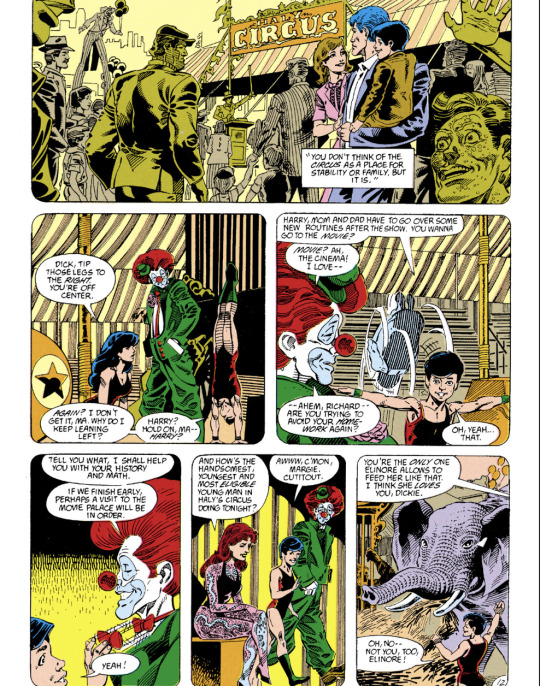
Aww. Such a cute elephant!
Batman 436 comes out in August 1989. New Titans 60 comes out a few months later, in November, and guess what? When Dick visits the circus, he is suddenly surprised by an unexpected blast from the past! It turns out that even though it's been years, Elinore still remembers him!
Here's the part where Elinore remembers Dick:
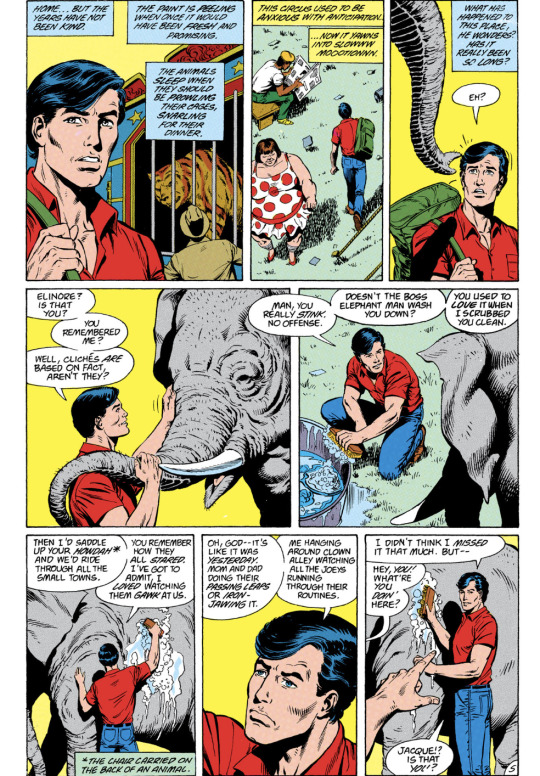
SUCH a cute elephant. I love her.
(Guess who else still remembers Dick even though it was so long ago. Guess which other character is about to be an unexpected blast from the past. Guess which character Elinore is directly paralleling guess guess guess sorry everything is about Dick and Tim in my mind but I can focus I swear)
Four years later, in 1993, Batman: The Animated Series retells Dick's origin story. They like and keep Wolfman's elephant, but they change her name to Zitka:
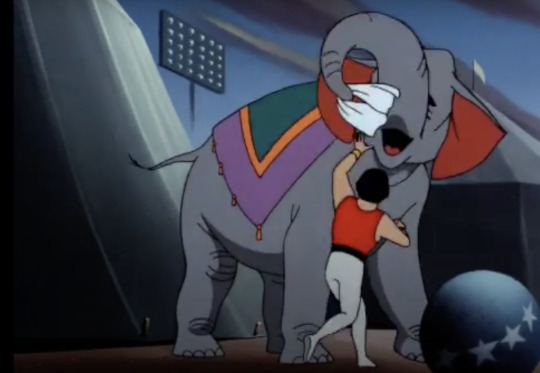
Wolfman doesn't return to the elephant beyond those two appearances, and a few years down the line, New Titans gets cancelled and Wolfman's not writing Dick anymore anyway. So the animal gets abandoned for a while, until Devin Grayson, a fan of both Wolfman and B:tAS, revives the Wolfman-era Titans team in JLA/Titans and then the ongoing series Titans 1999.
Grayson then brings back the elephant in a flashback to Dick's past in Titans 16 (Jun 2000), where she imports the B:tAS name. Sometimes I'm skeptical of TV-to-comics imports, but honestly, I endorse this one. You lose the alliteration, which is a shame, but IMO Zitka is a better elephant name than Elinore.
Here's Dick with the newly-christened Zitka in Titans 16:
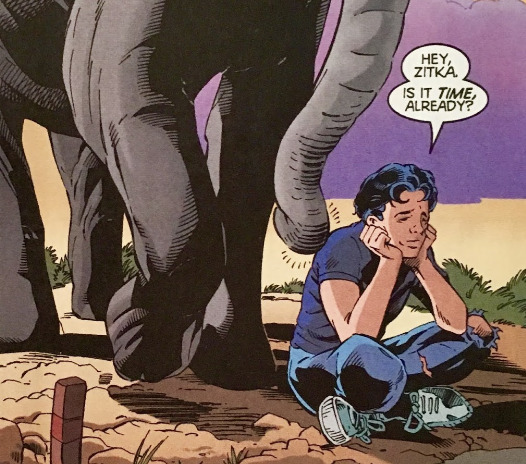
Grayson also briefly references the elephant in Gotham Knights 20 and - in a final angsty callback - in Nightwing 88 (Feb 2004), where Zitka tries futilely to comfort Dick in the midst of his trauma conga line:
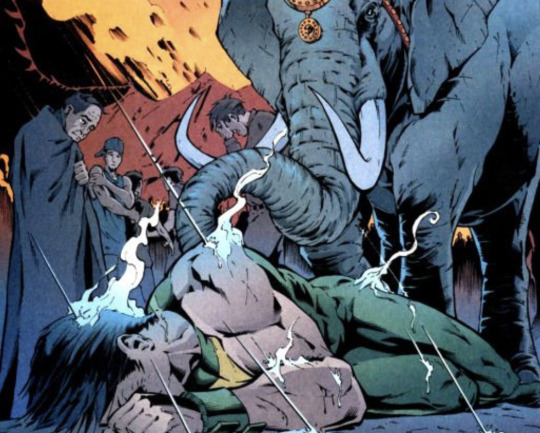
... And... honestly, I think that's it for comic appearances? The two Wolfman comics plus the three Grayson comics.
Both Wolfman and Grayson are writing multiple titles - Batman, New Titans, Titans, Gotham Knights, and Nightwing between the two of them, spanning a big chunk of Dick's post-Crisis canon - and both writers use the elephant for heartwarming moments of nostalgia, which means if you're doing a post-Crisis readthrough for Dick, Elinore/Zitka feels memorable. But I don't think she actually shows up that much.
For post-2011, I am not as well-informed - throwing this out to the dash? anyone know? - but I feel like Zitka the heartwarming symbol of Dick's heartwarming circus past is, uh, thematically very at odds with the Court of Owls evil!circus vibes, so my instinct is that this story element was almost certainly dropped in the reboot.
Did Dick ever have a stuffed elephant toy in comics?
In WFA, yes; in main comics continuity, no. Technically, I have not read every comic ever published, so I could be wrong!! But I don't think so.
Below, find my rambling reasoning on the tonal vibes of pre-Crisis, post-Crisis, and post-2011, and why this particular story element doesn't seem right to me for the first two.
Pre-Crisis (...okay, mostly the Silver Age): stuffed animal, yes or no?
tl;dr no, requires too much background knowledge on the part of the reader, plus the elephant wasn't a thing until later
Elinore doesn't get created until post-Crisis, but also just generally, pre-Crisis callbacks are more along the lines of this reference in Batman 129 (published in 1960), where, wow, Batman and Robin are hunting jewel thieves - and it turns out Robin recognized this strongman! BUT HOW?!
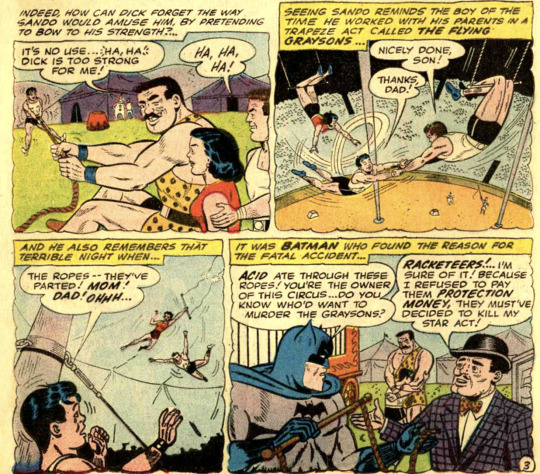
The comic goes on to recap Dick's entire origin story in flashback, on the assumption that you may not know it.
(BTW, if you'd like to know more about Haly's Circus throughout the years, nightwingology has a great post here summarizing a lot of fun plotlines and characters!)
Basically: Silver Age comics are very self-consciously episodic and kid-friendly; they're not generally gonna do overly-elaborate callbacks because they don't know what comics their kid readers may have randomly picked up or remember.
By the time of post-Crisis, comic books were being written for an adult audience buying from the direct market, i.e. readers who are collecting whole runs & don't need or want Dick's origin story to be recapped to us in full every time it's referenced. That's why in post-Crisis, we get stuff like "hey, neat, this particular soda brand is getting mentioned in several different books!!" or "in order to understand this story arc, buy SIXTEEN DIFFERENT COMICS in FIVE DIFFERENT RUNS and read them ALL ACCORDING TO A NUMBERED ORDER and also you better be following the individual plotlines and recognize these five minor characters who we don't bother to introduce!! Good luck!!" But the elaborate post-Crisis plotlines - and subtler worldbuilding like a stuffed animal callback to Dick's backstory - don't make a lot of story sense UNLESS you're imagining your readers as completionist adult fans.
So IMO a stuffed animal wouldn't be a pre-Crisis thing unless it was The Episodic Story Of the Week, and I don't think a stuffed animal is action-adventure-y enough for the fast-paced storytelling of the Silver Age. (Unless it, like, came to life and tried to eat you or something.)
Post-Crisis: stuffed animals, yes or no?
tl;dr: no, Dick's a manly tough guy, he's not gonna have a stuffed animal, that'd be lame, like something Tim might do
Part of the edgy grimdark adult vibes in 80s/90s comics is that some characters who used to be kinda silly & goofy & lighthearted - like Batman and Robin - get reimagined as Serious and Angsty and Edgy in a Tough Cool Manly Brooding Way. This massively affects characterization for Bruce, Dick, and Bruce and Dick's relationship.
(I obviously love this change & love the tense Bruce-and-Dick interactions, but plenty of fans of the earlier fluffy comics really disliked the edgy retcons of Miller / Wolfman / Starlin / et al.)
The upshot is that post-Crisis is a period when you could have a recurring reference like a stuffed elephant, but you wouldn't have a stuffed elephant, not for Dick. I think a toy like that would be too cutesy / childish / effeminate to give a male character in post-Crisis, unless you were poking fun at him.
Now, you could probably let Tim have a stuffed animal, because Tim is sometimes cool but also sometimes a tryhard loser who is faking being cool and not entirely pulling it off (see e.g. the Robin comic where he practices tough-guy faces in the mirror, or the Teen Titans comic where Conner discovers his cringy Enya CD, or when he's fanboying over Connor and it's awkward, etc etc.). A stuffed animal would be deeply embarrassing, and you'd have to be careful to compensate by having Tim do something cool afterward - but Tim's character concept allows for "he's kind of a loser sometimes."
But Dick isn't!! In post-Crisis, Dick's a tough / impressive / "cool guy" character, the kind of guy anyone would want to be, even in the flashbacks where he's Robin, and even in the stories where he's more lighthearted than angsty. It'd be kinda lame for Dick to have a stuffed elephant, so he wouldn't. I feel like Dick would be more likely to poke fun at it if someone had one, like when he's making fun of Wally for liking the Hardy Boys. Dick could have a Batman action figure, at most, and if he had one he would have it ironically.
Basically: in post-Crisis, a male character hugging a stuffed elephant feels more likely to be a punchline to me, not something poignant. (Even with Tim, Tim could have an embarrassing stuffed animal, but he couldn't hug it when sad - that's too far. Maybe Booster Gold might do this. Probably he wouldn't, but spiritually, he would. Sorry Booster ilu! <3)
Instead, Dick instinctively deals with his inner turmoil like the TORTURED ACTION HERO he is: by punching things and brooding and yelling and joining the mob and sleeping on rooftops and going on obsessive secret missions and acquiring Angsty Stubble!! Just like Batman!
(Technically I don't know if Bruce ever joined the mob but you know he would.)
Anyway as you know this is my favorite continuity and I am poking fun affectionately, but uh, yeah sdfsfdsfs. No stuffed animals.
Post-2011 / Infinite Frontier / Wayne Family Adventures: stuffed animals, yes or no?
tl;dr it's in WFA! Probably not anywhere else, but it could be.
Post-2011 stuff tends to be cutesier overall, most of all in the current Infinite Frontier era. So I don't feel like this would be tonally out-of-line with IF comics. Taylor tends to go for more meme-y references rather than fanfic references, though.
So the obvious best fit is WFA, which is aiming for a rough approximation of Silver Age family-friendly vibes - wholesome, episodic plots, Teaching Good Moral Lessons For The Youth, etc. - plus lots of Easter eggs for fanfic readers and some comic references.
And look, here we are:

Aww.
Whew - that's everything I could find!
Anyway as you can probably tell, I LOVE the elephant, so this was a very entertaining rabbit hole to go down, thank you <3
#dick grayson#anyone with more info feel free to chime in & we can crowdsource <3#i do think the toy elephant is awfully cute though <3#total digression but i was thinking about it as i was writing:#i'm fascinated by the ways that the post-crisis batboys & their stories can intersect with 90s masculinity and all its issues with stoicism#and i'm pro-queering and gender-bending - 90s comics were a total boys' club so i think it's neat that transformative fandom isn't#but i do love 90s masculinity and All Its Issues too & one of the things i find compelling about the dick-tim-bruce trio#& especially dick's place in it - is the unspoken hierarchy whereby bruce is manlier than dick & dick is manlier than tim#and so dick's in the middle as this somewhat softer-character who aspires to be a harsher & more stoic & ultimate manly-man character#caught in the middle between robin & batman & what each role represents#and like. batman is both manhood & the only desirable thing to be AND ALSO it represents this immense narrowing of possibility#because so much of stereotypical masculinity is about reducing the range of emotions you're allowed to have or express#and dick is both incredibly conflicted about bruce AND wants to be just like him & by extension is conflicted about masculinity writ large#so a lot of dick's interactions with tim veer between trying on a frat-boy-ish 'I'm The Manly Guy' persona vs. giving up on it#or trying on imitations of Bruce's Batman persona but also trying to backtrack out of it bc he doesn't like how it feels etc etc#ANYWAY i think what i am trying to say is that if tim had a stuffed animal dick would be entertained & poke mild fun at him#and call him 'teddy' for the next hour or something while tim got increasingly defensive about how the teddy bear was steph's#and/or about how the teddy bear was OLD and tim doesn't even care about it and also WHATEVEr i'm above this#and to an uninformed observer this might look like bullying BUT ACTUALLY#this ritual would IN FACT be very reassuring to both of them + tim would feel WAY better afterward than if dick had ignored it#because by poking fun at him dick shows he still respects tim enough to tease him thus subtextually exorcising the threat of wimpiness#plus allowing tim to defend himself & demonstrate that he can take a joke so they've both reaffirmed their masculinity to each other#& they don't have to be scared of the teddy bear and all it represents anymore#however also afterward dick would have a brief nostalgic flashback to when he was a kid & had a teddy bear & feel weird about the memory#because he would be unable to articulate to himself that what he misses is a past when he allowed himself to be vulnerable#anyway this wouldn't actually happen in comics but it's what would happen in my soul. you know.#ask tag#zitka
141 notes
·
View notes
Note
Nothing in Batman comics is canon because it’s literally 90% fanfiction written after the actual creators stopped writing the characters.
anon it doesn't work that way.
By that logic, practically noone exists because the original writer of Batman, Bob Kane and Bill Finger, only created Bruce, Dick, Alfred, and the villains gallery. That's it.
No Barbara, no Jason, no Tim, no Damian, Steph, Cass, Duke, Lucius, Tim Fox, Kate, Talia - there's no one then.
But suppose we go back on that statement and say 'well actually, the creators of new characters', which still doesn't make sense but let's go with that. Then major plots wouldn't happen. Because Max Allan Collins and Chris Warner created Jason Todd but Judd Winick is the one who brought him back to life. Marv Wolfman and Pat Broderick created Tim Drake but Alan Grant wrote a lot of the Robin comic and Batman comic characterization for him.
It's physically impossible to say that just because other people continued the series, the comics can't be taken seriously.
Comics are the source material. Of which fanfics are based on.
The Star Trek and Star Wars book series are written by multiple different authors but that doesn't mean that what's written doesn't happen or isn't true or is wrong. The 39 Clues and Doctor Who series are the same deal.
Batman comics are canon. Because if only the works of the original authors of Batman were to be considered canon, then practically everyone in the Batman universe doesn't exist/doesn't matter. Because they're just fanfic then.
But this idea doesn't just stop at the Batman fandom anymore because every comic was written this way. The people in Superfam? Gone. Flashfam? Gone. Arrowfam? Gone. Like this logic doesn't just apply to Batman, it applies to virutally every character in the existence of DC.
The beauty of comics is seeing how the next writer will continue the story. Sometimes they're right, sometimes they need tweaking, and sometimes they're wrong although that's usually very rare.
The problem with fandom's view on comic writing is the belief that whatever the authors create must match our perspective of the characters. That's wrong. Their characterization is what we should be adding on/building on to our perspective of the characters. Unless there is something so wrong, something so illogical, that it must be noted because that character has never acted that way before, then we must discard or critisize a comic.
Comics develop. Characters develop. Each writer brings something new and adds a layer of depth to each character they write about. That's how we get new interactions, new relationships, new sides that make each character interesting.
Take the original Dick Grayson comic and his intro to Robin
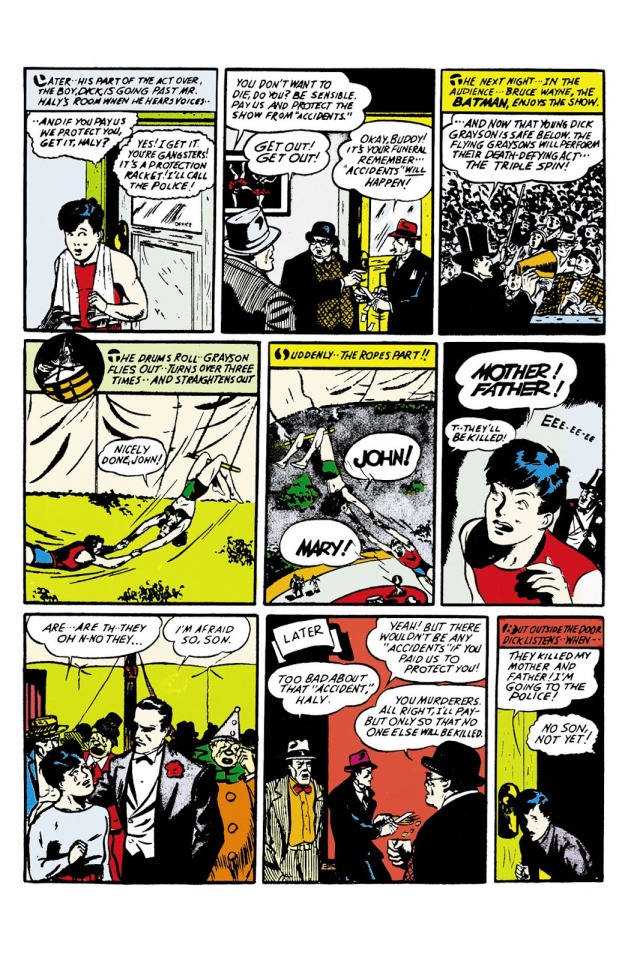
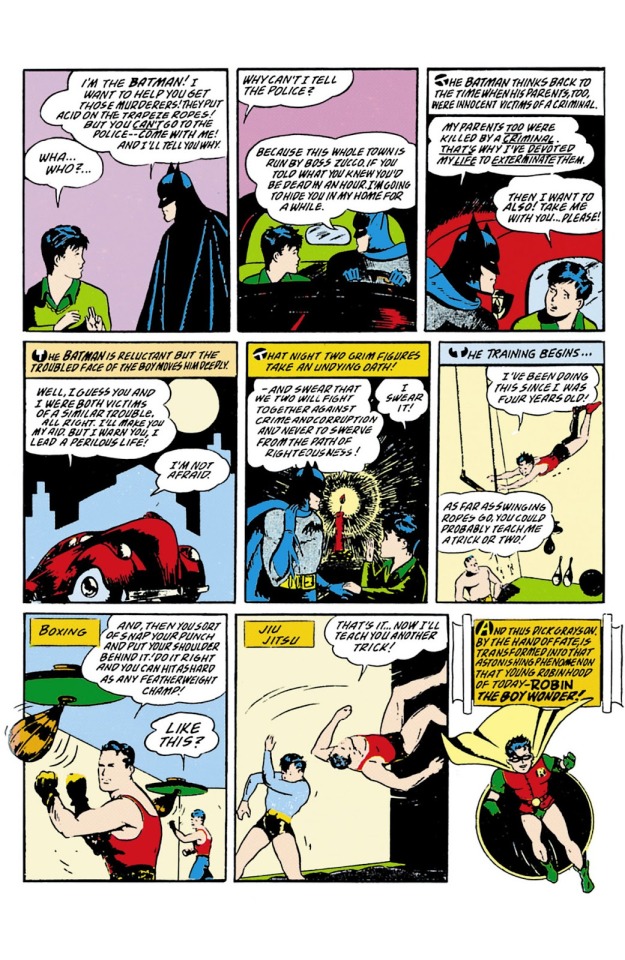
Detective Comics (1937) Issue #38
Dick originally wanted to go to the police. He had no intention of going after Tony Zucco but Bruce is the one who demands they go after him together by themselves!
I love this version created by Bob Kane and Bill Finger, but I also love the version created by a completely different author where Dick decides to stake out Zucco on his own. Both versions show different sides of him and authors sometimes even choose which one they want to include. Some have gone with this version where Dick tries to go to the police before being interrupted by Bruce and others have gone with the second, more famous version. But neither of them are bad and you can't say that the one where Dick goes after Tony Zucco is fanfiction. It's canon. If it's written in comics, it happened unless there's some disastrous, glaring contradiction.
You have to understand, these comics - especially Dick and Bruce's - are nearly 100 years old. Dick, and it's wild to think about this, existed before even the Justice League did. Wonder Woman, Green Arrow, and Aquaman were all created after him. If the orginial writers stopped writing, and noone picked it up, there would be no Justice League and that's a problem because the Justice League is one of the foundations of the DC comics.
So much has changed in a century and new writers constantly come in to show that change. That's why comics after the original writers finish writing are still canon and important. The original characterizations of all these major players were all super peppy and cheerful before new writers added angst and drama to their backstories. Bruce and Dick used to laugh and grin when they went crime fighting with no sadness or anger or other emotions. It wasn't until a couple decades later where writers started writing that in which is how we get the grim avenger Batman today.
Here's the third point to why they're relevant even though they're written by new authors: the passage of time in real life, is included in canon comics characterizations.
One comic talks about Dick discussing the Joker and he says, "at the beginning, it was just all fun and games. He would cause problems but at the end of the day it was a game. But one day, things went too far. People got shot. That day, the Joker changed. He was darker and evil. It wasn't games anymore."
This comic panel talks about the Golden Age to now, the progression and development of characters.
The comics and reality are inseparable because reality is literally written in. The works of writers after the orignal ones aren't arbitrary or some whimsical thing.
It's very different from fanfiction because fanfiction has no need to stick to the truth or canon characterization but these comic writers do because they have an obligation to do so. The only problem they might have is accidentally focusing too much on one aspect of a character and neglecting the other parts but almost none of them are way off the mark.
So no, for the sake of characterization, personality development, plot events, and new interactions, all comics are extremely important and definitely canon. Us readers might have different opinions and thoughts on them but it's irrelevant in the face of the fact that the comics are the only truth to which we can base our interpretations on.
#canon vs fanon#dick grayson#nightwing#bruce wayne#batman#tim drake#red robin#jason todd#red hood#damian wayne#robin#stephanie brown#spoiler#cassandra cain#black bat#barbara gordon#batgirl#alfred pennyworth#lucius fox#kate kane#batfamily#superfamily#flashfam#arrowfam#tagging everyone because this is important#cl anon asks#thanks for the ask!
232 notes
·
View notes
Text
Beast Machine Hunters> The First Story Bible part 4
BW Media Spotlight concludes the story portion of Marv Wolfman's treatment in Beast Machine Hunters> The First Story Bible part 4
Two more to go and this one will be a bit short to make sure I have enough room to do all the deep character profiles together. That will end our look at Marv Wolfman’s original story treatment for Beast Hunters, the show that was reworked into Beast Machines. Last time we had a small problem in that the file I’m using had a page in the wrong spot. I don’t know whose to blame and I wish I had…

View On WordPress
#Beast Hunters#Mainframe Entertainment#Marv Wolfman#story treatment#Transformers#Transformers: Beast Machines
0 notes